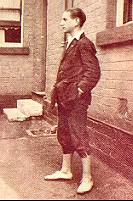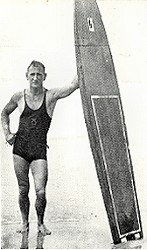 |
surfresearch.com.au
daily mail : mcalister, cornwall, 1928 |
| home | catalogue | history | references | appendix |
|
Andrew 'Boy' Charlton
was one of Australia's most succesful competitive swimmers and a regular
surf shooter at Manly Beach.
On his visit to
Europe in 1928 to compete in the Amsterdam Olympic Games, he was accompanied
by his trainer and fellow Manly surfer, Harry Hay.
Hay was one of several
local surfers instructed in surfboard riding by Duke Kahanamoku during
his Austalian tour in 1914-1915, subsequently became a jounalist and wrote
one of the earliest surfing books,
Swimming
and Surfing in 1931.
The 1500 metre Olympic
champion at the 1924 Paris games, in 1928 Charlton came second in the 1500
metres and second in the 400 metres.
Other swimming competitors
included the American team members Johnny Weismuller and Buster Crabbe,
both competed with Kahanamoku and both later played the role of Tarzan
in Hollywood films.
On the day of 400 metre semi-finals:
"Among the crowd
that day was a group of Charlton supporters who had come from the Manly
Surf Club, including two late arrivals, Sandy (sic) McAlister and
Tommy Farrell.
They had saved
every penny to travel tourist class on the liner Jervis Bay with
just one purpose: to see their close friend win the 1500 metres.
When a stowaway
caused the Jervis Bay to be delayed they transferred to another
vessel, but further problems occurred in London and they missed the race.
Having gone forty-eight
hours without sleep they arrived at the pool while Charlton's 400 metres
heat was being swum.
McAlister, a
champion board rider, talked his way on to the starting boards and saw
the rest of the races from a prime position."
- Fenton: They Called Him Boy (2006) page 189.
Following the Olymic
competition, McAlister travelled to England, apparently with a surfboard,
and was
interviewed by the
Daily
Mail about his intention to surf on the beaches of Cornwall.
McAlister's comment,
"At
Manly Beach, Sydney, there are 20,000 persons who bathe everyday" is
likely an exaggeration.
Similarly, "At
the end of each season we have our championship contests, the most important
being the surf riding", possibly overstates the status of boardriding
at the surf life saving carnivals of the period.
The most popular
and dramatic events were probably the surf boat races.
Mr. Justin C. McAlister, an electrical engineer of Sydney, New South Wales, the amateur surf-riding, champion of Australia, who has just arrived in England after attending the Olympic games in Amsterdam with the Australian team, said to a reporter:
At Manly Beach, Sydney, there are 20,000 persons who bathe everyday, and at this spot and at other favourite resorts there are surf life-saving clubs composed entirely of amateurs.
At the end of
each season we have our championship contests, the most important being
the surf riding.
Surfboard-riding
is the most thrilling sport that I know of, and I would like to see it
generally introduced into England.
A surf-board is
about nine feet in length and about two feet wide, tapering to a blunt
end.
You paddle the
board out about 250 yards, and, if skilled, pick your wave.
You propel yourself
forward with your arms, and when you feel the swell carrying you towards
the shore your test comes.
The secret consists
of keeping your balance.
If your are experienced
you find the right balancing point, and it is possible to stand on your
head.
If you get on
the crest of the wave you rush forward at a speed of at least of at least
25 miles an hour.
Mr. McAlister
is searching for a suitable beach to make this sport popular.
At the moment
he has only has in mind Newquay, Cornwall.
 |
 |

| home | catalogue | history | references | appendix |